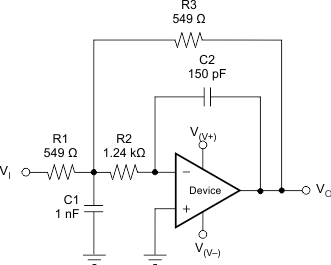ZHCSJD6 February 2019 OPA2356-EP
PRODUCTION DATA.
- 1 特性
- 2 应用
- 3 说明
- 4 修订历史记录
- 5 Pin Configuration and Functions
- 6 Specifications
- 7 Detailed Description
- 8 Application and Implementation
- 9 Power Supply Recommendations
- 10Layout
- 11器件和文档支持
- 12机械、封装和可订购信息
8.2.4 Active Filter
The OPA2356-EP is designed for active filter applications that require a wide bandwidth, fast slew rate, low-noise, single-supply operational amplifier. Figure 35 depicts a 500-kHz, second-order, low-pass filter using the multiple-feedback (MFB) topology. The components are selected to provide a maximally-flat Butterworth response. Beyond the cutoff frequency, roll-off is –40 dB/dec. The Butterworth response is preferred for applications requiring predictable gain characteristics, such as the anti-aliasing filter used in front of an ADC.
One point to observe when considering the MFB filter is that the output is inverted, relative to the input. If this inversion is not required, or not desired, a noninverting output can be achieved through one of the following options:
- Adding an inverting amplifier,
- Adding an additional second-order MFB stage,
- Using a noninverting filter topology, such as the Sallen-Key (see Figure 36).
MFB and Sallen-Key, low-pass and high-pass filter synthesis is quickly accomplished using TI’s FilterPro™ program. This software is available as a free download at www.ti.com.
 Figure 35. Second-Order Butterworth 500-kHz Low-Pass Filter
Figure 35. Second-Order Butterworth 500-kHz Low-Pass Filter  Figure 36. OPA2356-EP Configured as a Three-Pole, 20-kHz, Sallen-Key Filter
Figure 36. OPA2356-EP Configured as a Three-Pole, 20-kHz, Sallen-Key Filter